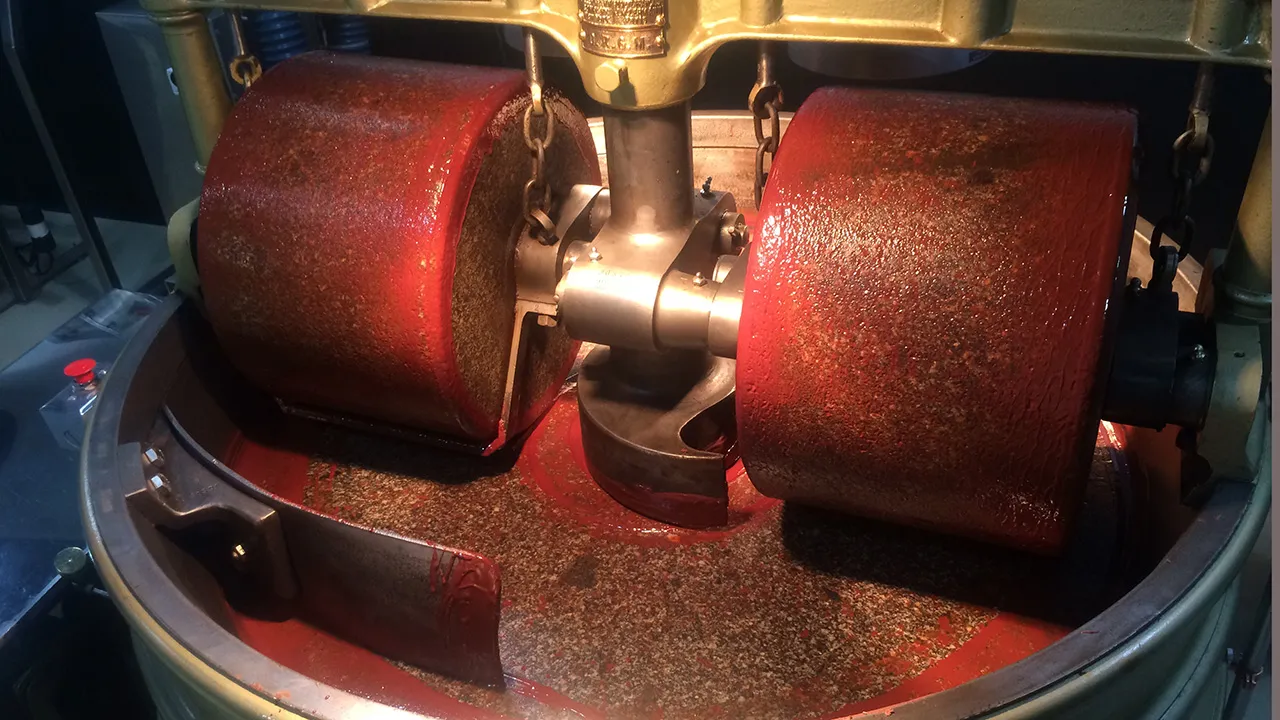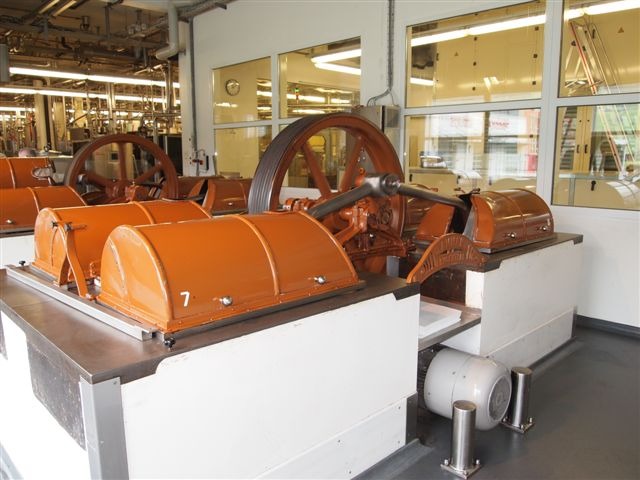AMA: Ask Me Anything (About Cocoa or Chocolate) #8: What is Conching?

The Question
This is another assertion that is not usually put in the form of a question. Rather, it is the misuse of a technical term: melangers (or melangeurs, a French term for mixer) are very often referred to as conches. Technically, melangers are a form of universal, so-called because all of the processing steps in chocolate making – grinding, refining, and conching – are performed in the same device.
Sometimes it feels like tilting at windmills going over this, but it’s important to me for accuracy.

What Conching Is and Isn’t
Conching is not about refining, or reducing the particle size, of a chocolate.
Conching does two things: develop the texture of a chocolate and develop the flavor of a chocolate. The following descriptions are gross oversimplifications but they touch on the basic outcomes of the process.
Texture development during conching is a mechanical process that involves a) breaking up particle agglomerates (clumps of sugar and/or nib), and b) making sure that all of the particles are covered with fat, making them more difficult to detect on the tongue. Conching is not about refining particles below a certain size or to achieve a particular particle size distribution. Proper and efficient texture development requires a different kind of shearing action than the shear, for example, between a grinding wheel and base or between the grinding material in conventional ball mills.
Flavor development is a lot about the selective evaporation of unwanted volatile aromatic compounds (VOCs). Alkalization (Dutch processing) is an indiscriminate chemical process; in addition to reducing acidity, alkalization affects many other volatile aromatic chemicals. With mechanical conching, heat and airflow are used instead of chemicals. By controlling temperature and airflow it is possible to gain more precise control over the final flavor outcome.
When texture development and flavor development are done independently the two processes are not interdependent and there is less worry of over-processing in one aspect to achieve the desired result in the other. When they are done together in the same machine – and one that was not designed for this purpose – it’s much more difficult to time flavor and texture development to be at their optimum at the same time.
How do I know all this stuff? I helped design the first purpose-built, dedicated, conche for specialty/craft chocolate makers back in 2013-2014 for FBM in Italy. It was (and is) called the Kleego (which I got to name: Klee from Paul Klee, originally pronounced “clay”, but pronounced like flee, and “go” from Gordon; Kleego = Clay Gordon).
We scaled it to process a 35kg batch out of a 65L stone grinder/refiner. Where particle size distribution can be achieved in roughly 24 hours in these devices, working on flavor can take another 24-48 hours or more. In the Kleego conching can typically be performed in 2-3 hours with independent control of the shear required for texture development and heat and airflow required for flavor development)..
Hundreds of Kleegos have been sold to award-winning specialty/craft chocolate makers around the world since its introduction.
Who Invented/Discovered Conching?
Rodolphe Lindt (yes, that Lindt) is credited with the invention of the conche / discovery of the conching process in 1879.
The story goes that Lindt was experimenting with a new machine and forgot to turn it off on a Friday evening before leaving for the weekend. Upon his return on Monday he thought that the chocolate would be ruined but instead found it transformed in both texture and flavor. Mechanical shear over an extended period of time transformed the texture and the heat evaporated off the acetic acid left behind from fermentation revealing other, delicate, aromas that were hidden by it.
Two Conching Myths
- Longer conching times are necessarily better. In fact, longer conching times are not necessarily better than shorter conching times. The only thing guaranteed by longer conching is that it adds cost to the process.
- The number of hours of conching tells you something meaningful. Some makers list the conching times on the label. Without knowing the exact process – what kind(s) of refining processes are used, and if a separate conche is used, for example – it’s not possible to learn anything from a raw number. (And see Myth 1).
The basic processes for making chocolate have been well understood for at least 100 years. Most of the development of new machines in the last 50 years has been in the application of a better understanding of physics and chemistry to processes in order to reduce the amount of time required to perform particular steps and to otherwise increase efficiency. It is possible to perform both flavor and texture development of a refined chocolate in under 2-3 hours (and much faster in a thin-film conche) in a dedicated, purpose-built, modern, conche with precise, repeatable, digital controls. There is no readily discernible difference between a chocolate conched this way and one that was conched for 48-72 hours that can reliably be attributed to the method of conching.
Conching in an old-style longitudinal conche may be more romantic. but that does not make it necessarily better in any objective sense. There may be a placebo effect attributable confirmation bias, but that would be entirely subjective. The one thing we can confidently assert is that the longer conching takes the more expensive it is.
Why I Contend Melangers Aren’t “Real” Conches
Most of the melangers in use today are based on kitchen appliances originally created in Indian cuisine – they took (and take) the place of blenders and food processors. They were never intended to refine cocoa beans, sugar, and other ingredients into finished chocolate.
Some advantages of melangers:
- Melangers are easy to learn how to use and easy to understand how they work – in principle.
- They are relatively inexpensive.
- It is only necessary to purchase one machine to transform nib into chocolate.
- It is relatively easy to scale up production from a small lab-scale melanger to a larger production melanger. (But, scaling up into a bank of melangers may just be the least environmentally sustainable way to scale production, IMO.)
However, even though melangers are relatively easy to understand and use, when it comes to making consistently good chocolate consistently, their use is something of a black art without a solid understanding of the physics and chemistry involved and being meticulous and precise.
- In a melanger, texture and flavor development are dependent processes.
- In a melanger, there is only one kind of shear – the shear at the very tiny contact patch between the grinding wheel and the base, and it’s the same shear for the entire length of processing. If you leave the stones in contact after the desired particle size distribution has been achieved, the refining process continues during “conching”. Raising the stones off the base stops the refining action, but there is no separate or sufficient kind of mechanical shear happening to break up particle agglomerates. In a two-ingredient chocolate with no added cocoa butter the extra viscosity exacerbates these issues.
- In most melangers there is no way to control the temperature reliably. To some extent it can be controlled by changing the speed of rotation, but slowing the rotation lengthens the time required. Acetic acid tends to evaporate more quickly when the temperature is above 60C. You’d want to get the chocolate above this temperature at the start of conching and then drop the temperature once the acid is no longer apparent in the chocolate. Airflow (temperature-controlled) over the surface of the chocolate can help move the evaporated volatile aromatics away from the surface of the chocolate quickly and efficiently. There is very poor airflow over the surface of chocolate in most melangers.
It is primarily for these reasons that I believe that melangers can not be called conches. While they may perform aspects of conching (they actually do conche), they are very inefficient at both flavor and texture development.
Why Don’t More Makers Buy Dedicated Conches?
I believe there are many reasons:
- They are not as romantic as stone grinders. Romanticism is a big aspect of specialty/craft chocolate.
- Many makers don’t believe it’s possible to conche quickly. They misunderstand that just because it possible doesn’t mean it’s required. While it is possible to conche in 2-3 hours, it’s only necessary to conche more quickly than it takes to refine a batch.
- Many makers don’t think it’s desirable to conche quickly – taking more time and requiring more labor are good things in specialty/craft chocolate and are to be leaned into embraced, not avoided.
- Many makers think they’re too expensive – misunderstanding how conches can increase quality and consistency while reducing production costs. It’s actually cheaper to buy a small conche than a second melanger.
Want to know more?

What are your thoughts about conching? Please share with the community in the comments below.
